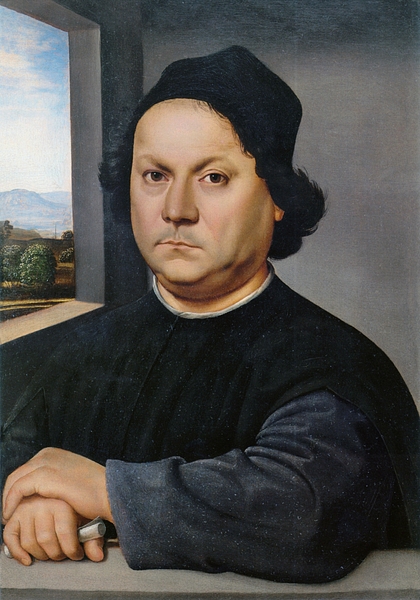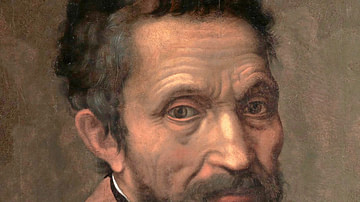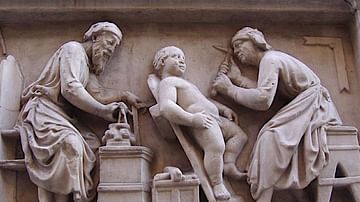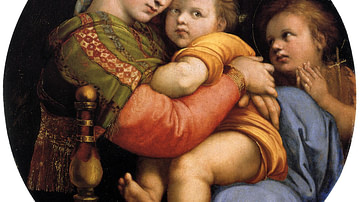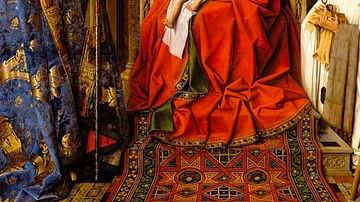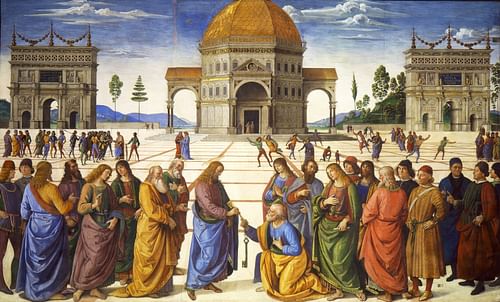
Pietro Perugino (c. 1450-1523 CE), real name Pietro di Cristoforo Vannucci, was an Italian Renaissance artist who created frescoes for the Vatican's Sistine Chapel and was in demand across Italy to decorate church interiors and produce portraits of the ruling class. Perugino was very often interested in creating a sense of space in his works, especially between the main action in the foreground and precisely rendered examples of architecture in the background. The artist's use of space and perspective was influential on many Renaissance artists who followed, notably his one-time pupil Raphael (1483-1520 CE).
Early Life
Pietro di Cristoforo Vannucci was born around 1450 CE in Cittá del Pieve near Perugia, central Italy, hence his more widely known name Pietro Perugino. Born into a humble family, Perugino lived in poverty until he made his name as an artist. It is possible that Perugino studied under the celebrated Umbrian artist Piero della Francesca (c. 1420-1492 CE) whose interest in colour and mathematical perspective clearly influenced the apprentice. It also seems likely that Perugino became the assistant of the Florentine artist Andrea del Verrocchio (c. 1435-1488 CE) who also trained such future Renaissance stars as Leonardo da Vinci (1452-1519 CE). Indeed, Perugino's first appearance in the historical record is in Florence in 1472 CE, then very much the painting capital of Italy.
The Perugino Style
Perugino's paintings were very different from those of the Florentine artists. The Umbrian artist preferred to place his figures at the front of his pictures with a large space behind leading to precisely drawn examples of architecture in the background. The Thames and Hudson Dictionary of the Italian Renaissance gives the following concise summary of what exactly characterised Perugino's work:
Static, non-dramatic, gently classical in pose and clothed in soft, relatively heavy material falling in simple folds, his figures mark the changeover from mid-century linearity. His pictorial architecture is likewise characterised by uncluttered, grave simplicity and the eschewing of unnecessary details. (244)
The Sistine Chapel
In 1475 CE Perugino was commissioned to paint frescoes in the interior of Perugia's Palazzo Communale. Successfully establishing himself as an artist of note, his reputation spread beyond Umbria and Tuscany. Around 1478 CE, Pope Sixtus IV (r. 1474-1481 CE) commissioned him to create a fresco for Saint Peter's Basilica (the old version) in Rome. The Pope must have been pleased with the results in Saint Peter's because c. 1481 CE he employed the artist to paint a fresco scene for the right interior wall of the Sistine Chapel in Rome. This was a prestigious commission as the chapel would involve many of the very best of Italy's Renaissance artists. Some historians suggest that Perugino may have overseen the entire decoration project of the chapel.
The Sistine Chapel panel Delivery of the Keys to Saint Peter is a good example of Perugino's love of presenting scenes with a sense of space. In this case, there appears to be acres of space between the foreground figures and the precisely drawn church and triumphal arches behind them. The perspective techniques include the converging lines in the middle ground paving and the smaller size of the figures mid-painting. The precise balance of the picture - seen in the matching arches, the architectural features of the church, and the arrangement of foreground figures - is, if anything, reinforced by the asymmetrical line of trees in the background.
This masterpiece has another interesting facet, the accompanying texts chosen by the artist. Above the fresco and its counterpart on the right (Cosimo Rosselli's Last Supper), an inscription reads in a single line across the wall: 'Challenge to Jesus Christ, bearer of the law'. Then, in a reminder of the subservient relationship of Renaissance artists to their illustrious patrons, the two triumphal arches in the fresco carry the following extravagant line of praise: 'You, Sixtus IV, unequal in riches, but superior in wisdom to Solomon, have consecrated this vast temple' (Paoletti, 305).
Perugino also painted a fresco of the Assumption of the Virgin on the altar wall of the Sistine Chapel but this would be covered between 1536 and 1541 CE by Michelangelo's own fresco The Last Judgement. This was not a unique case, and other artists suffered a similar treatment over the decades of the Renaissance. Fortunately, a drawing of the lost fresco survives, likely made by a member of Perugino's workshop. It shows Pope Sixtus himself kneeling as a donor, offering his decorated chapel to the Virgin while Saint Peter himself touches his shoulder with the key to the gates of Paradise.
The Perugia Workshop
Around 1496 CE Perugino produced frescoes for the Collegio del Cambio in Perugia. Next there came his Crucifixion with Saints for Florence's Santa Maria Maddalena de' Pazzi church. In 1498 CE he painted a celebrated altarpiece showing the Virgin and Child with Saint Michael and Saint Raphael which is now in the National Gallery in London.
Returning to Perugia, Perugino ran a workshop where young artists were trained, including, from 1499 CE, one future super-star of the Renaissance, Raphael Sanzio. Raphael would adopt his master's interest in creating a sense of space in his paintings and frescoes - see, for example, his 1504 CE Marriage of the Virgin (Pinacoteca di Brera, Milan). Perugino also ran a workshop in Florence contemporary with that in Perugia. In demand across Italy, commissions, especially for portraits, continued to come in from Mantua, Naples, Orvieto, and Siena. Altarpieces showing the Virgin Mary and saints were another ever-popular product of Perugino's workshops where he and his assistants produced drawings from real-life models. These drawings - of heads, torsos, various postures, etc. - would then be combined to create a unique set of individuals for each altarpiece design. This efficiency was not so appreciated by art critics, especially the rival Florentines who made fun of Perugino's recycling of the artistic ideas that had brought him so much success earlier in his career. Michelangelo was not impressed with Perugino's work either and called it primitive. The sting was enough for Perugino to go before a magistrate over the matter but this did nothing to improve his reputation.

Sometime between 1500 and 1504 CE, Perugino was given what must have been a most satisfying commission, a painting for the cathedral of his home town. The subject of this work, now in the Musée de Beaux-Arts in Caen, France, is the marriage of Joseph and Mary. It was an entirely appropriate choice as the cathedral's most precious relic was a ring said to have been the very one given to Mary.
Final Works & Death
One of the master's last major works was the Battle between Love and Chastity painting for Isabella d'Este (1474-1539 CE), wife of Gianfrancesco II Gonzaga (1466-1519 CE), then ruler of Mantua. The work was created between 1503 and 1505 CE and now resides in the Louvre, Paris. As with other artists who created paintings for Isabella, Perugino was obliged to follow very precise instructions on the subject matter (a long letter from Isabella survives) and this, also like other artists, resulted in him producing something quite different from his usual work. The painting measures an impressive 1.91 x 1.6 metres (6'3.5” x 5'3”). It shows Artemis/Diana and Athena/Minerva, who represent chastity, fighting with success against Aphrodite/Venus and Cupid, who represent lasciviousness. The scene still has Perugino's preference for a line of characters in the foreground and there is the usual abundance of space behind them but the figures are much more whimsical than previously seen in his work. There is also a noticeable absence of any architecture, Perugino not even being tempted to cross Isabella and add a picturesque ruin to the scene.
In 1508 CE Perugino was still respected enough to earn a commission to paint roundels (decorative medallions) in the ceiling of the Vatican Palace's Stanza dell'Incendio. Significantly, though, it was his former pupil Raphael, the new star of Renaissance art, that won the more important commission of the wall frescoes in the same room. Working to the very end, Perugino died of the plague in Fontignano near Perugia in 1523 CE. Perugino earned a chapter in the celebrated history of Renaissance artists The Lives of the Most Excellent Italian Architects, Painters, and Sculptors (1550 CE, revised 1568 CE) by Giorgio Vasari (1511-1574 CE), although he must settle for sharing that chapter with, who else, the pupil who overshadowed his work in his own lifetime, Raphael.
